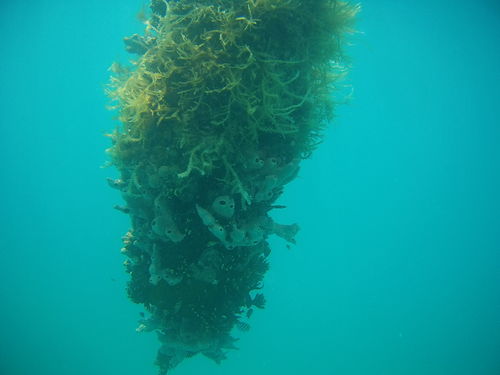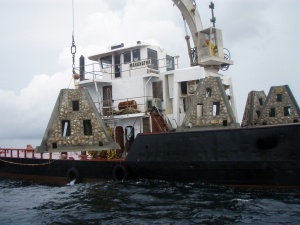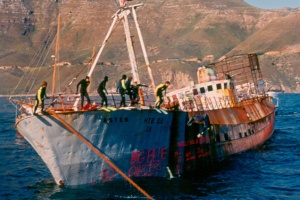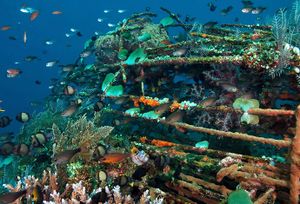ArtificialReefs
Artificial Reefs
What are Artificial Reefs?
An artificial reef is a human-made underwater structure that substitutes as a natural reef to form a habitat for marine life. Artificial reefs are placed in areas where there is little bottom topography or near coral reefs to attract marine populations. These structures are made from a variety of materials including shipwrecks, construction debris, oil rigs, concrete, and any other man-made objects[1]. Bridges, lighthouses, and other offshore structures can also act as artificial reefs[2]. By providing shelter from predation and surfaces for encrusting organisms to grow on, the man-made structure creates a habitat. Lower-level food chain organisms attract predators increasing the biodiversity. As time passes the reef is colonized by sponges, hard and soft corals, algae, numerous fish species, crustaceans, and many other creatures. Typically, artificial reefs do not take as long to establish as natural coral reefs. Artificial reefs may be intentional or unintentional.

Why Artificial Reefs?
Artificial reefs serve to protect coral reefs form human-induced damages as well as supporting biodiversity and healthy ecosystems. In addition, they are used for mitigating coastal erosion, creating surf breaks, and in the past have been built to block ships from entering coastal waters. These structures create plankton-rich feeding spots that attract small animals and the reef soon becomes covered by encrusting coral and sponges. The collection of smaller marine organisms brings in predators and expands to establish a new habitat. The significance of this is that these spots can divert reef-enthusiasts, like divers and boaters, from endangered coral reefs to the artificial reef[1][3]. Not only do artificial reefs serve as protectors, but they can be used to maintain fisheries management and promote ecotourism for Small Island Developing States.
Fisheries Management
Fisheries management allow for sustainable management by protecting the ecosystem and the economic reliance on fisheries[4]. This means controlling our behavior, marine habitats, and marine resources to estimate fish mortality and produce optimum yield. To manage these components of fisheries, artificial reefs have been implemented to manipulate marine habitats. It is easily mistaken that artificial reefs are an encompassing solution to fisheries management since there are no adverse side effects, but there are very few applications of this, so there are limited examples to follow. Establishing artificial reefs creates two scenarios that promote sustainability of fish populations and fishing. In one scenario the reef increases the environmental carrying capacity by establishing an additional habitat. This therefore increases biomass. In the other scenario the artificial reef serves to aggregate fish and makes them more vulnerable to being harvested by fishermen. One demonstration in fisheries management has been the deployment of concrete modules in Algarve, Portugal to build an artificial reef complex as part of the Algarve Artificial Reef Program. This program studied the colonization process, the role of reefs as nursery grounds for juvenile protection, fish and benthic invertebrate assemblage, water chemistry, the use by the fishing community, and the socio-economic impact on the local community. The results of this program include an increase in the mean number of species, a high level of biomass, confirmation of the increased proportion of fish as juveniles, and demonstrated the multiple roles artificial reefs serve for recruitment, nursery grounds, and reproduction for adults[5].
History
Artificial reefs have been around since the Neolithic time period, and then more prominently in 17th century Japan. People noticed that putting simple structures made from bamboo and palm leaves in the water attracted fish. This logic was backed by science and looked more heavily into in the 1830’s in the United States. The idea of FADs, or, Fish Attraction Devices was fine tuned over the years and now looks like the artificial reefs that we see today[6]. Throughout this page, we will cover the different types of artificial reefs you will see today, what works and what does not work, and the benefits and harms of artificial reefs.
Types of Artificial Reefs
Artificial reefs generally fall into two categories, manufactured and recycled. Though the purposes of artificial reefs may vary, effective reefs must be heavy, non-toxic, and resistant to erosion and other forms of physical and chemical wear[7][8][9].


Manufactured
Most modern manufactured reefs have a bamboo fiber, synthetic fiber, or metal framework, which is then covered in a mixture of neutral-pH concrete and calcium carbonate (limestone). A higher proportion of concrete creates a stronger structure. However, this increases the acidity of the structure, making it less habitable for coral polyps[9].
Electro Mineral Accretion (EMA)
EMA is a method of crystallizing limestone on a metallic structure, via an electric current within a solution that contains dissolved calcium carbonate (limestone). A low voltage current is run through the structure, which can be generated by floating solar panels on the surface or by a battery. This current prevents rust and promotes the crystallization of the limestone forming an attractive habitat for coral[10]. The nooks and crannies of calcium carbonate formed this way are also highly appealing to small marine organisms.
Mass produced and custom concrete structures
Organizations such as Reef Ball are currently at the forefront of artificial reef design and production. Due to the expense of production and placement, many NGOs are at the forefront of artificial reef design, placement, and purchase. Reef Balls and other customizable structures undergo extensive testing to ensure their stability and resistance to the physical and chemical wear encountered in marine environments. The customizable aspects of these structures, such as variations in size, material, and other parameters can be utilized to provide an ideal habitat for a desired species in a specific region[8].
3-D Printed Artificial Reefs
In recent years, 3D printers have become faster, cheaper, and more accurate. Now, companies like Design Lab have begun using a technique called Modular Artificial Reef Structure (MARS) to design and 3D print artificial reefs. This technique makes it possible for more intricate and unique structures to be created. 3D printing allows for easier modifications in designing structures with different cavity sizes, forms, and textures in order to cater to different marine speciesCite error: Invalid <ref> tag; invalid names, e.g. too many.
- According to some studies, rapid colonization, high fish densities, and high catch rates were consistently present on artificial reefs a few months after placement[8][11].
Disadvantages of Artificial
- Manufactured reefs, and even some recycled reefs, involve expensive labor costs for production and for the cleaning and stripping of recycled materials.
- The cost of the transportation and actual placement of artificial reefs can also be very high, as they must be brought out by ships and are usually placed by the means of cranes and extensive floats to ensure that they are properly positioned[9].
- The possible introduction of toxins by artificial reefs must also be considered, specifically in the case of scuttled ships and other equipment. If cleaning and stripping of the structures is not done thoroughly, toxins such as lead, mercury, or heavy oils can harm the surrounding waters and marine life.
- The large initial investment of an artificial reef is also a large commitment. If the reef fails to become populated, there is little that can be done to rectify the initial investment.
- It has been suggested that only 50 percent of artificial reefs meet their established goals[8]. However, additional studies are needed[7].
Eco-tourism and Artificial Reefs
In addition to increased marine life populations, new dive sites lead to new economic opportunities[12]. Reefs that gain larger, healthier populations due to the placement of artificial reefs, and the addition of aesthetically interesting structures are a magnet for snorkelers, recreational scuba divers, and photographers. For many developing coastal nations, artificial reefs provide a cheap option to attract tourists in an otherwise poor market. The placement of artificial reefs leads to a long term profit, where tourists will continue to visit, and fisheries will see increased populations and production[13]. If placed close to shore, in an easily accessible area, increased and easily located fish populations attract tourists interested in fishing[8]. An increased volume of tourists attracted by the reefs will create a demand for hotels, restaurants, and other markets associated with tourism[13].

References
- ↑ 1.0 1.1 "What Are Artificial Reefs and Where Are They Located in the Mid-Atlantic? | Mid-Atlantic Coastal Environment." EPA. Environmental Protection Agency, 24 Jan. 2013. Web. 26 Feb. 2013.
- ↑ National Marine Sanctuary Foundation. (27, May. 2022). What Are Artificial Reefs? Retrieved from https://marinesanctuary.org/blog/what-are-artificial-reefs/
- ↑ Heller, Greg. "Surfing A to Z." Artificial Reefs Explained. Surfline, n.d. Web. 26 Feb. 2013.
- ↑ NOAA Fisheries. (n.d.). Understanding Fisheries Management in the United States. Retrieved from https://www.fisheries.noaa.gov/insight/understanding-fisheries-management-united-states
- ↑ Bortone, Stephen A. Artificial Reefs in Fisheries Management. Boca Raton, FL: CRC, 2011. Print.
- ↑ Samurović Katarina. Geography Realm. (21, Nov. 2022). Artificial Coral Reefs. Retrieved from https://www.geographyrealm.com/artificial-coral-reefs/
- ↑ 7.0 7.1 Carr, Mark H., and Hixon, Mark A. “Artificial Reefs: The Importance of Comparisons with Natural Reefs.” Fisheries 22.4 (1997) 28-33. Print. 26 Feb. 2013.
- ↑ 8.0 8.1 8.2 8.3 8.4 Bohnsack, James A., and David L. Sutherland. "Artificial reef research: a review with recommendations for future priorities." Bulletin of Marine Science 37.1 (1985): 11-39. Print. 26 Feb. 2013.
- ↑ 9.0 9.1 9.2 Baine, Mark. "Artificial reefs: a review of their design, application, management and performance." Ocean & Coastal Management 44.3 (2001): 241-259. Print. 26 Feb. 2013.
- ↑ Taylor, Andrew CF. "ELECTRO MINERAL ACCRETION." Encyclopedia of Modern Coral Reefs: Structure, Form and Process (2011): 368.
- ↑ Randall, John E. "An analysis of the fish populations of artificial and natural reefs in the Virgin Islands." Carib. J. Sci 3.1 (1963): 31-47. Print. 26 Feb. 2013.
- ↑ Cite error: Invalid
<ref>tag; no text was provided for refs namedseaman - ↑ 13.0 13.1 Baum, J. K., D. Kehler, and R. A. Myers. "Robust estimates of decline for pelagic shark populations in the northwest Atlantic and Gulf of Mexico." FISHERIES-BETHESDA- 30.10 (2005): 27.